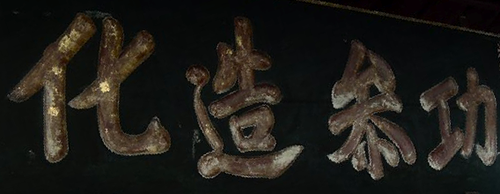21. The "Katakana Hi" Radical: 匕
The "katakana hi" radical 匕 is on duty in only two Joyo kanji (and perhaps just one, as we'll see):
北 (205: north; to flee)
化 (238: to change; disguise oneself; bewitch)
The 匕 shape also serves as a component in many other characters, including 花 (flower) and 指 (finger).
When a radical is as simple as the two-stroke 匕, the meaning of the shape tends to be less clear than that of pictorial radicals. And so it is with 匕.
On 北
Henshall calls 北 a "pictograph of two people back-to-back in profile" in his newer edition (the source of all his etymologies in this Radical Note). Thus, 北 originally meant "to turn back on" or "retreat." He considers "north" a loan usage or perhaps an extended sense; the idea is that ancient Chinese houses faced south, so occupants turned their backs to the north.
Photo Credit: Eve Kushner
On this package of wasabi-flavored kelp, 北 means "north" in 北海道 (ほっかいどう: Hokkaido). It may seem that our 匕 radical reappears twice in the first large kanji:
昆布 (こんぶ: kombu; brown Japanese seaweed)
But Henshall indicates that the bottom half of 昆 isn't actually a duplicated 匕. Rather, it's 比, originally representing "two people in line; compare" and in this case meaning "people gathered together." Alternatively, he says, 昆 may depict an insect, with the 比 standing for the legs lined up underneath! (By the way, the word kombu comes from Ainu, says Daijisen, so it's safe to conclude that 昆布 is ateji, rather than anything involving insects!)
Henshall's take on the lower half of 昆 raises a useful point. When you think you're seeing 匕, you may actually have encountered this radical:
比 (radical 81: "comparing")
The Names of the 匕 Radical
One might search for the meaning of 匕 in its nomenclature. Known as "katakana hi" or "spoon" in English, the radical goes by these names in Japanese:
さじのひ
さじ
ひ
Apparently, the さじ comes from the yomi of the non-Joyo 匙 (spoon). Because 匙 contains that on-duty radical, someone probably thought to associate 匕 with 匙 in these radical names. Actually, our radical doubles as a non-Joyo kanji that means "spoon" (and "knife"!) and that has the same さじ pronunciation. But the Japanese connect spoons much more with 匙 than with 匕, which they almost never use as an autonomous character. For this reason, my proofreader suspects that the reading of 匙 gave rise to the yomi of our radical.
And then ひ is the hiragana equivalent of the katakana ヒ. (Note the minuscule differences in that kana versus radical 21. Most notably, the lower right part of our 匕 radical curves upward, whereas the kana ヒ sticks to the baseline.)
Incidentally, don't call the 匕 radical ひ because that's unclear, as two other radicals—日 (radical 72: "sun") and 火 (radical 86: "fire")—share that name.
Primarily, the Japanese refer to 匕 as さじのひ, combining the ideas of the spoon and katakana ヒ.
The Meanings of 匕
I discovered something about the meaning of 匕 in Henshall's etymology for this kanji:
化 (238: to change; disguise oneself; bewitch)
He says that the right side represents "person fallen down," which indicates a "change of state," and he notes that the 亻 means "person standing."
Until I saw his analysis, I didn't realize that sources disagree about the radical of 化. Kanjigen goes with 匕, as does Joy o' Kanji. By contrast, Henshall and Denshi Jisho classify the character under 亻, a variant of 人 (radical 9: "person"). Siding with them would leave 北 (205: north; to flee) as the only Joyo kanji featuring an on-duty 匕 radical.
The Variant of 匕
In his etymology of 化, Henshall illuminates another issue. Whereas the Japanese render the 匕 radical as we're seeing it here, the Chinese do it as 七. That shape, which Nelson lists as a variant form of our radical, appears in the following photo.
In the photo above, the radical of 化 looks a lot like 七, the kanji for "seven," which made me wonder about the radical of that character. It turns out not to be 匕 but rather 一 (radical 1: "one")! Go figure! Henshall says in his etymology of the 七 character that it derives from a pictograph of a "cut bone."
Kanjigen similarly notes that 七 originally meant “to cut,” as in cutting the vertical line with the horizontal one. The same source also says that 七 once constituted the whole character now written as 切 (156: to cut). The 七 shape appears in just two Joyo kanji, the other being 叱 (2026: to scold). In the last section of "Oddball Additions to the Joyo Set" I discuss the quirkiness of the 叱 shape.
It seems that very little is straightforward when it comes to our radical! Both the meaning and the form are rather slippery!

